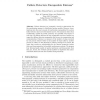Free Online Productivity Tools
i2Speak
i2Symbol
i2OCR
iTex2Img
iWeb2Print
iWeb2Shot
i2Type
iPdf2Split
iPdf2Merge
i2Bopomofo
i2Arabic
i2Style
i2Image
i2PDF
iLatex2Rtf
Sci2ools
114
Voted
OPODIS
2010
2010
Failure Detectors Encapsulate Fairness
Failure detectors are commonly viewed as abstractions for the synchronism present in distributed system models. However, investigations into the exact amount of synchronism encapsulated by a given failure detector have met with limited success. The reason for this is that traditionally, models of partial synchrony are specified with respect to real time, but failure detectors do not encapsulate real time. Instead, we argue that failure detectors encapsulate the fairness in computation and communication. Fairness is a measure of the number of steps executed by one process relative either to the number of steps taken by another process or relative to the duration for which a message is in transit. We argue that oracles are substitutable for the fairness properties (rather than real-time properties) of partially synchronous systems. We propose four fairness-based models of partial synchrony and demonstrate that they are, in fact, the `weakest systems models' to implement the canonica...
Distributed And Parallel Computing | Failure Detectors | OPODIS 2010 | Partial Synchrony | Real Time |
Related Content
| Added | 14 Feb 2011 |
| Updated | 14 Feb 2011 |
| Type | Journal |
| Year | 2010 |
| Where | OPODIS |
| Authors | Scott M. Pike, Srikanth Sastry, Jennifer L. Welch |
Comments (0)

